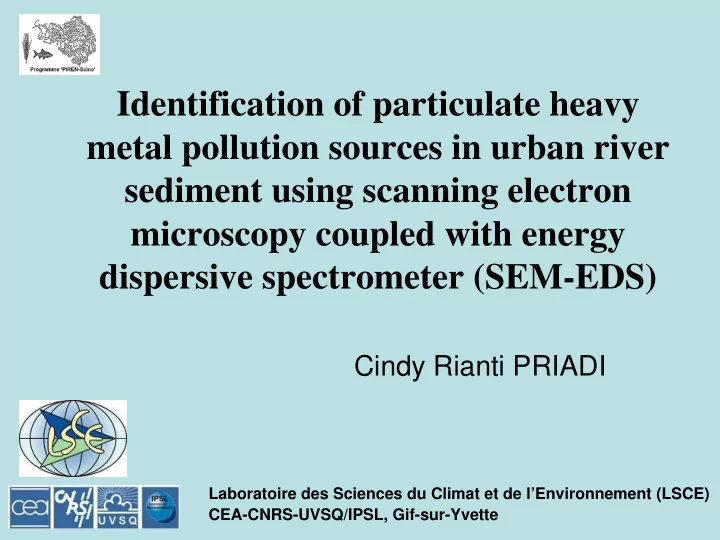

Identification of particulate heavy metal pollution sources in urban river sediment using scanning electron microscopy coupled with energy dispersive spectrometer (SEM-EDS) Cindy Rianti PRIADI Laboratoire des Sciences du Climat et de l’Environnement (LSCE) CEA-CNRS-UVSQ/IPSL, Gif-sur-Yvette
Presentation plan • Watershed and heavy metal • Urban river sediment: the Seine River case • Scanning Electron Microscopy • Results • Conclusion and Prospectives www YES 13-16 May 2008
Multiple natural and anthropogenic sources of heavy metals… Cd Cu Cr Hg Pb Ni Zn As Se www YES 13-16 May 2008
Urban metal particles www YES 13-16 May 2008
…..Reflecting in human • Small amount = Air Air useful or useless; Food and water Food and water beyond = toxic • Bioaccumulate • Form (speciation) dependent contact contact www YES 13-16 May 2008
Multiple natural and anthropogenic sources… www YES 13-16 May 2008
….In the Seine Riv www YES 13-16 May 2008
12% of France Metropolitan Territory, but… QuickTime™ et un décompresseur TIFF (non compressé) sont requis pour visionner cette image. • 25% agricultural activities • 25-30% industries • Upper Seine: up to 30 p/km • Lower Seine: 250 p/km 2 www YES 13-16 May 2008
High metal content in SPM and Sediment (- -) Estuary sediment Background SPM Flood deposit (Horowitz et al 1994, Grosbois et al 2006) Sediment deposit 5RNB 2003) Oise Sediment (Dessery 1982) M. Meybeck et al., 2007 •European Water Framework Directive demands a good ecological level for water bodies •Priority substances including Nickel, Plomb, Mercure, Cadmium and urban metals including Copper, Chrome, Zinc www YES 13-16 May 2008
Metal n+ Source Metal Particulate binding phase - Iron oxyde - Sulfide - Calcite… Precipitation Metal n+ www YES 13-16 May 2008
Common Methodology: Tessier Method www YES 13-16 May 2008
Common Methodology: Tessier Method Chemical analysis by ICP-AES/MS www YES 13-16 May 2008
Direct observations www YES 13-16 May 2008
Direct observations Scanning Electron Microscopy coupled with Energy Dispersive Spectrometry www YES 13-16 May 2008
www YES 13-16 May 2008
12-14 cm Depth A Sam pling site of Seine sedim ent B 25-30 cm 45-50 cm Depth www YES 13-16 May 2008
Pb Zn Cu Cr Ni V (µg/g) (µg/g) (µg/g) (µg/g) (µg/g) (µg/g) Sediment A 188,51 572 109,33 105,62 39 133,58 12-14 Sediment B 286,75 604 156,02 91,06 32,47 14,13 25-30 Sediment B 383,61 695 232,1 95,59 34 32,31 45-50 www YES 13-16 May 2008
Zn Zn 80 60 Percentage Pourcentage 40 20 0 Fe3O4 BaSO4 SiO2 Ca other non- fractions identified )A 12-14(38 )B 25-30 (48 )B 45-50 (50 www YES 13-16 May 2008
Zn Zn 80 Barite from road and automobile pollution vs 60 Zinc from roof and gutter Pourcentage Percntage runoff (El Samrani et al, 40 2004) 20 0 Fe3O4 BaSO4 SiO2 Ca other non- fractions identified )A 12-14(38 )B 25-30 (48 )B 45-50 (50 www YES 13-16 May 2008
V V 45 Calcium, SIlicon, Iron, 40 Vanadium and Chromium 35 compose basic oxygen Pourcentage Percentage 30 furnace steel slag, partially reused for road 25 construction (Chaurand et 20 al., 2007) 15 10 5 0 Fe3O4 Fe2TiO4 FeS2 SiO2 Ca non- identified )B 25-30 (36 www YES 13-16 May 2008
Cu 80 70 ? 60 Pourcentage 50 40 30 20 10 0 Fe3O4 BaSO4 FeS2 SiO2 Ca d'autres non- fractions identifiˇ A 12-14(16) B 25-30 (20) www YES 13-16 May 2008 B 45-50 <50 µm (42) B 45-50 <50 µm FM (40)
www YES 13-16 May 2008
Sulfurized copper www YES 13-16 May 2008
Pb Pb 70 60 50 Sulfide as anImportant Percentage pourcentage binding phase in reducing 40 condition. A higher percentage of association in 30 deeper sediment as forms are crystallized and well 20 detected by the MEB 10 0 Fe3O4 BaSO4 FeS2 SiO2 Ca non- identified )A 12-14(32 )B 25-30 (22 )B 45-50 (12 www YES 13-16 May 2008
Ni Ni (non spinelle) 100 90 Percentage Nature of nickel to be associated 80 with iron sulfide in fresh water lake 70 sediment (Canavan et al.2007) and 60 pourcentage combined sewer overflow (El 50 Samrani et al.2004) 40 30 20 10 0 FeS2 Ca non-identified )A 12-14(28 )B 25-30 (27 www YES 13-16 May 2008
Conclusion: • Microscopic analysis as a powerful tool in analyzing heavy metal association with sediment • Urban surface runoff = Zn, V • Preferably Sulfide associated = Pb, Ni Perspective: Focus on particles controlling mobility and dissolution towards the dissolved fraction Calcite (Bonte et al 2002, Pepe et al., 2008) Iron oxyde (Elbaz-Poulichet et al. , 2006) www YES 13-16 May 2008
Thank you! www YES 13-16 May 2008
Recommend
More recommend